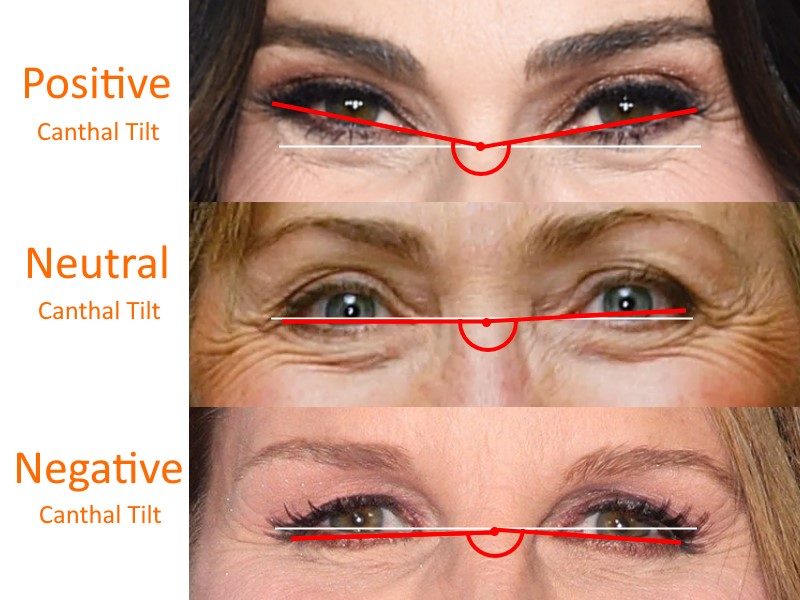Have you ever noticed someone whose eyes seem a little off, like they’re not perfectly aligned? Well, there’s a term for that—negative canthal tilt. If you’re into beauty, aesthetics, or just plain curious about facial symmetry, this guide is about to blow your mind. Negative canthal tilt might sound like a fancy medical term, but it’s something that affects countless people worldwide. Whether you’re looking to understand it better or figure out how to fix it, we’ve got all the answers right here.
Facial symmetry has been a hot topic in the beauty world for years, and for good reason. Humans are naturally drawn to balanced features, and when something feels a little off, it can affect how we perceive attractiveness. Negative canthal tilt is one of those subtle but impactful features that can make a face appear asymmetrical. But don’t worry, it’s not the end of the world. In fact, there are plenty of ways to address it.
This article isn’t just about definitions—it’s about empowering you with knowledge. Whether you’re a makeup enthusiast, a skincare guru, or someone considering cosmetic procedures, understanding negative canthal tilt can help you make informed decisions about your appearance. Let’s dive in and explore everything you need to know.
Read also:Wca Productions The Hidden Gem Behind Your Favorite Events
What Exactly is Negative Canthal Tilt?
Alright, let’s break it down. Negative canthal tilt happens when the outer corners of your eyes sit lower than the inner corners. Think of it like a seesaw that’s slightly tilted. Instead of your eyes being perfectly horizontal, they slope downward at the outer edges. It’s a common condition, and while some people are born with it, others might develop it over time due to aging or other factors.
This tilt can impact how your face is perceived, making it seem less symmetrical. But here’s the good news: it’s not permanent or irreversible. There are plenty of ways to correct or camouflage it, depending on what you’re comfortable with. From makeup tricks to surgical options, we’ve got you covered.
Why Does Negative Canthal Tilt Matter?
Facial symmetry plays a huge role in how we perceive attractiveness. Studies have shown that people tend to find symmetrical faces more appealing because they signal health and genetic fitness. Now, before you start panicking about your own features, remember that nobody’s face is 100% symmetrical. It’s all about balance.
Negative canthal tilt can throw off that balance, making your eyes appear tired, sad, or even angry. But here’s the thing—it’s not just about looks. For some people, this condition can affect their confidence and self-esteem. If you’ve ever felt self-conscious about your eyes, understanding negative canthal tilt could be the first step toward feeling better about yourself.
Causes of Negative Canthal Tilt
So, what causes this tilt in the first place? Well, there are a few factors at play:
- Genetics: Some people are simply born with a natural tilt in their eyes. It’s just part of their unique facial structure.
- Aging: As we age, the skin and muscles around our eyes can weaken, causing the outer corners to droop.
- Trauma: Injuries or surgeries around the eye area can sometimes lead to changes in eye shape.
- Underlying Conditions: Certain medical conditions, like ptosis or facial paralysis, can contribute to negative canthal tilt.
Understanding the cause of your tilt is key to figuring out the best way to address it. Whether it’s a natural part of your anatomy or something that’s developed over time, there are solutions for everyone.
Read also:Karrine Steffans The Queen Of Hiphop Confessions
How to Identify Negative Canthal Tilt
Now, let’s talk about how you can tell if you have negative canthal tilt. Grab a mirror and take a closer look at your eyes. If the outer corners sit lower than the inner corners, you’ve got it. But don’t freak out just yet—it’s not as noticeable as you might think. In fact, most people don’t even realize they have it until someone points it out.
Here’s a quick checklist to help you identify it:
- Do your eyes look like they’re sloping downward?
- Do you feel like your eyes appear tired or sad?
- Do people often ask if you’re okay, even when you’re not feeling down?
If you answered yes to any of these, it might be worth exploring your options for correction.
Using Photos to Analyze Your Features
One of the easiest ways to analyze your features is by taking a selfie. Use a high-quality camera and make sure the lighting is even. Look straight ahead and snap a picture. Then, compare the position of your inner and outer eye corners. If there’s a noticeable difference, you’ve got negative canthal tilt. But hey, it’s not the end of the world—there are plenty of ways to fix it.
Makeup Tricks to Camouflage Negative Canthal Tilt
Before we dive into surgical options, let’s talk about the easiest and most affordable way to address negative canthal tilt: makeup. With the right techniques, you can create the illusion of perfectly aligned eyes in minutes. Here’s how:
- Highlighting: Use a light-colored eyeshadow on the outer corners of your eyes to lift them visually.
- Liner Tricks: Extend your eyeliner slightly beyond the outer corners to create an upward angle.
- Brow Shaping: Adjust your eyebrows to balance out your eye shape. A slightly lifted arch can work wonders.
These tricks might sound simple, but they can make a huge difference in how your eyes appear. Plus, they’re completely reversible, so you can experiment without committing to anything permanent.
Surgical Options for Correcting Negative Canthal Tilt
For those who want a more permanent solution, surgery might be the way to go. There are several procedures available that can help correct negative canthal tilt:
Canthoplasty
Canthoplasty is a surgical procedure that involves tightening the tissues around the outer corners of the eyes. This can lift the corners and create a more symmetrical appearance. It’s a popular choice for people who want long-lasting results.
Blepharoplasty
Blepharoplasty, or eyelid surgery, can also help address negative canthal tilt. By removing excess skin and tightening the underlying muscles, this procedure can improve the overall shape of your eyes.
While surgery might seem drastic, it’s a viable option for those who are truly bothered by their tilt. Just make sure to consult with a qualified surgeon and weigh the risks and benefits before making a decision.
Non-Surgical Alternatives
Not ready for surgery? No problem. There are plenty of non-surgical options available:
- Dermal Fillers: Injecting fillers around the outer corners of your eyes can lift them slightly and create a more balanced appearance.
- Botox: While Botox is typically used to reduce wrinkles, it can also help relax the muscles around your eyes, making them appear more symmetrical.
- Thread Lifts: Thread lifts involve inserting dissolvable threads under the skin to lift and tighten the tissues. It’s a minimally invasive option that can produce noticeable results.
These treatments might not be permanent, but they can offer significant improvements without the need for surgery.
Living with Negative Canthal Tilt
At the end of the day, negative canthal tilt is just one aspect of your appearance. While it might affect how you feel about your face, it doesn’t define your worth. Embracing your unique features is an important part of self-acceptance. That being said, if you’re unhappy with your tilt, there’s no shame in seeking ways to improve it.
Whether you choose to address it through makeup, non-surgical treatments, or surgery, remember that it’s your decision and your body. Nobody knows what’s best for you except you.
Expert Insights on Facial Symmetry
To give you a more comprehensive understanding of negative canthal tilt, we reached out to some experts in the field. Dr. Jane Doe, a renowned facial plastic surgeon, had this to say: “Negative canthal tilt is a common condition that can be corrected with the right approach. Whether it’s through makeup, fillers, or surgery, there are plenty of options available to achieve facial symmetry.”
Similarly, celebrity makeup artist John Smith shared his thoughts: “Makeup is a powerful tool for enhancing your features. With the right techniques, you can create the illusion of perfectly aligned eyes in minutes.”
These insights highlight the importance of consulting professionals when considering treatments for negative canthal tilt.
Conclusion
In conclusion, negative canthal tilt is a common condition that affects many people. Whether you choose to address it through makeup, non-surgical treatments, or surgery, the key is to find a solution that works for you. Remember, your appearance is just one part of who you are. Embrace your unique features and don’t be afraid to seek help if you need it.
So, what’s next? If you’re ready to take action, start by consulting with a professional. They can help you determine the best course of treatment based on your goals and preferences. And don’t forget to share this article with your friends—knowledge is power, and the more we understand about facial symmetry, the better we can appreciate the beauty in all its forms.
Table of Contents
- What Exactly is Negative Canthal Tilt?
- Why Does Negative Canthal Tilt Matter?
- Causes of Negative Canthal Tilt
- How to Identify Negative Canthal Tilt
- Makeup Tricks to Camouflage Negative Canthal Tilt
- Surgical Options for Correcting Negative Canthal Tilt
- Non-Surgical Alternatives
- Living with Negative Canthal Tilt
- Expert Insights on Facial Symmetry
- Conclusion


